oil MAZDA MODEL CX-5 2018 Owners Manual (in English)
[x] Cancel search | Manufacturer: MAZDA, Model Year: 2018, Model line: MODEL CX-5, Model: MAZDA MODEL CX-5 2018Pages: 628, PDF Size: 82.38 MB
Page 24 of 628
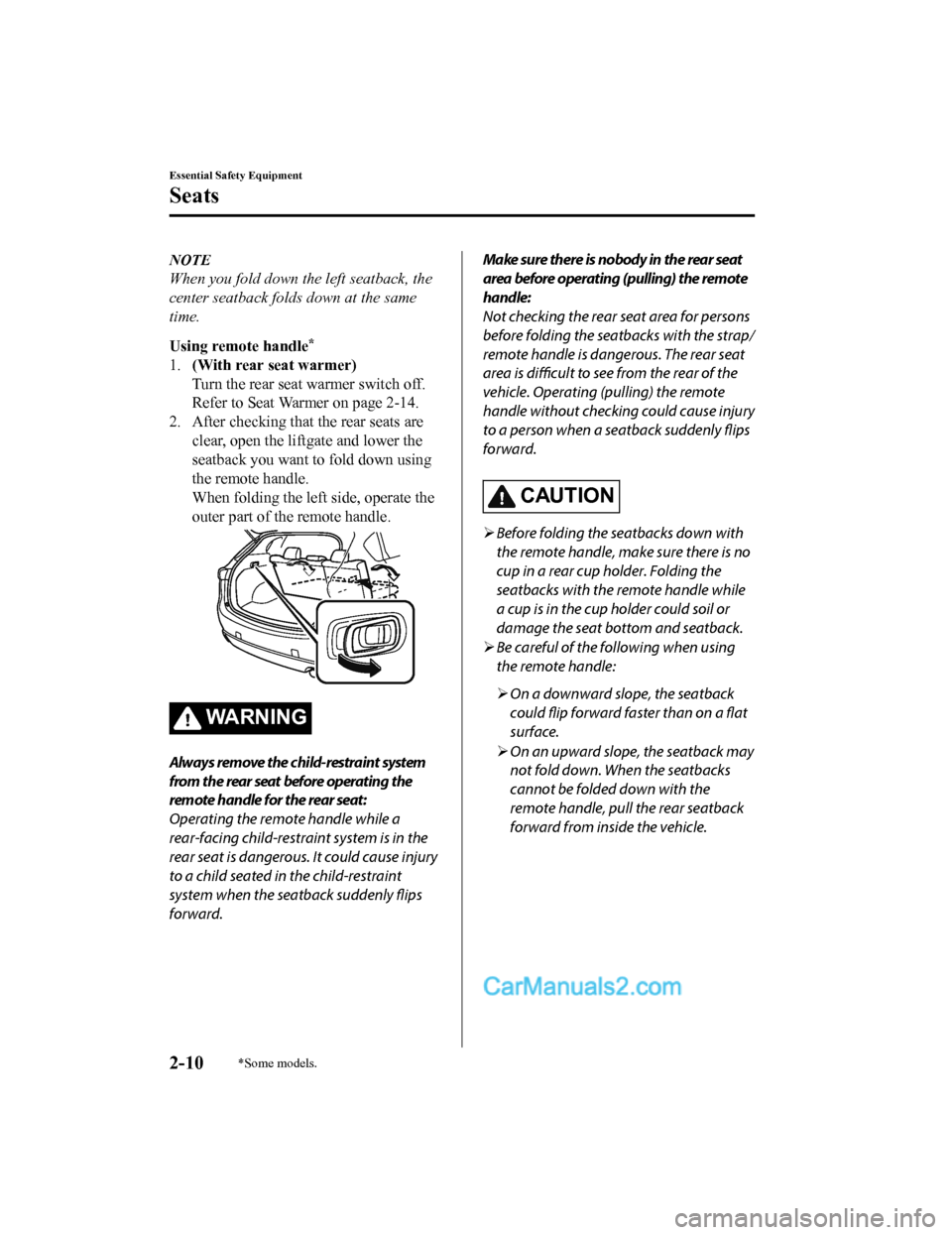
NOTE
When you fold down the left seatback, the
center seatback folds down at the same
time.
Using remote handle
*
1.(With rear seat warmer)
Turn the rear seat warmer switch off.
Refer to Seat Warmer on page 2-14.
2. After checking that the rear seats are
clear, open the liftgate and lower the
seatback you want to fold down using
the remote handle.
When folding the left side, operate the
outer part of the remote handle.
WA R N I N G
Always remove the child-restraint system
from the rear seat before operating the
remote handle for the rear seat:
Operating the remote handle while a
rear-facing child-restraint system is in the
rear seat is dangerous. It could cause injury
to a child seated in the child-restraint
system when the seatback suddenly flips
forward.
Make sure there is nobody in the rear seat
area before operating (pulling) the remote
handle:
Not checking the rear seat area for persons
before folding the seatbacks with the strap/
remote handle is dangerous. The rear seat
area is difficult to see from the rear of the
vehicle. Operating (pulling) the remote
handle without checking could cause injury
to a person when a se atback suddenly flips
forward.
CAUTION
Before folding the seatbacks down with
the remote handle, make sure there is no
cup in a rear cup holder. Folding the
seatbacks with the remote handle while
a cup is in the cup holder could soil or
damage the seat bottom and seatback.
Be careful of the following when using
the remote handle:
On a downward slope, the seatback
could flip forward faster than on a flat
surface.
On an upward slope, the seatback may
not fold down. When the seatbacks
cannot be folded down with the
remote handle, pull the rear seatback
forward from inside the vehicle.
Essential Safety Equipment
Seats
2-10*Some models.
CX-5_8GN5-EA-17J_Edition1 2017-8-18 12:58:27
Page 26 of 628
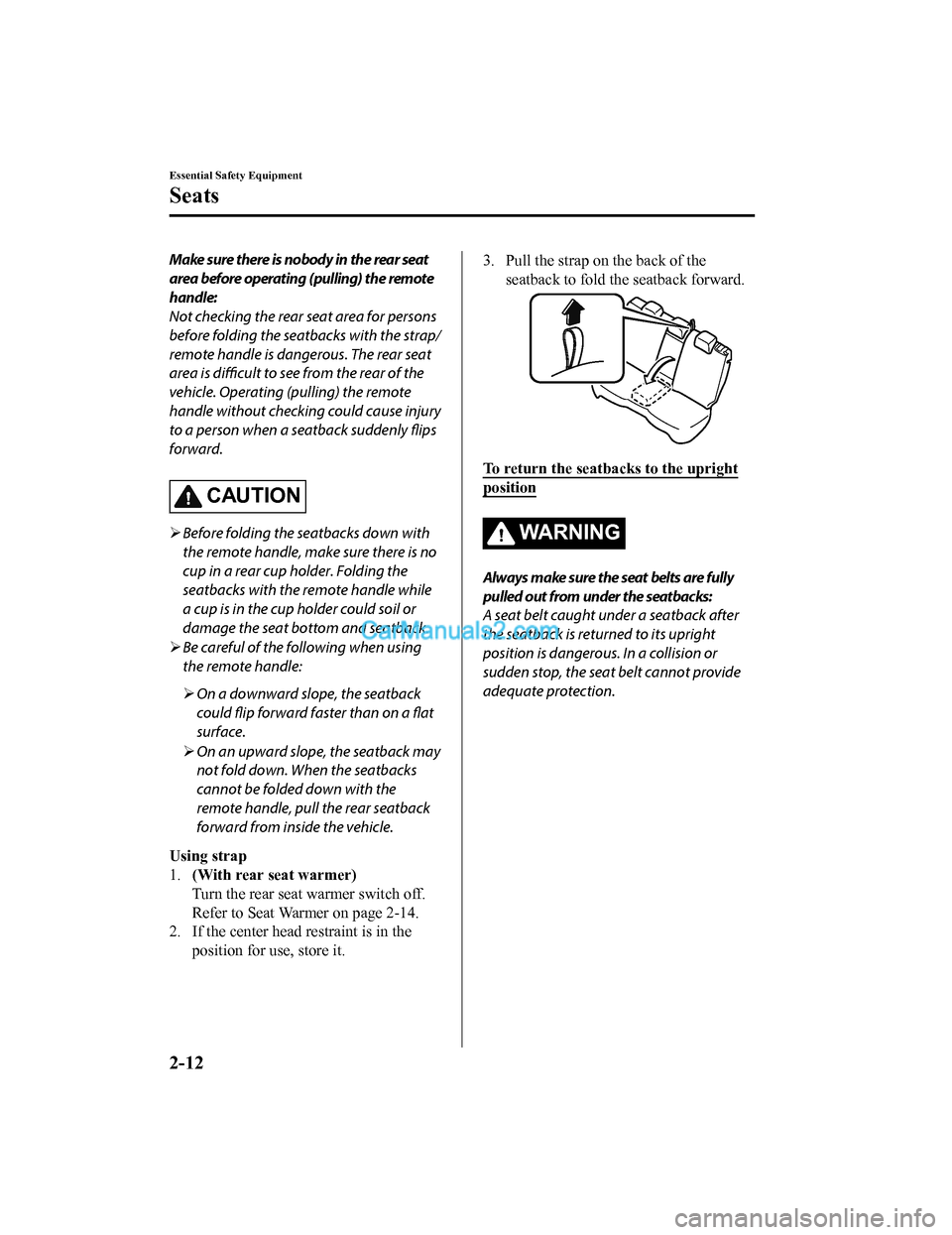
Make sure there is nobody in the rear seat
area before operating (pulling) the remote
handle:
Not checking the rear seat area for persons
before folding the seatbacks with the strap/
remote handle is dangerous. The rear seat
area is difficult to see from the rear of the
vehicle. Operating (pulling) the remote
handle without checking could cause injury
to a person when a seatback suddenly flips
forward.
CAUTION
Before folding the seatbacks down with
the remote handle, make sure there is no
cup in a rear cup holder. Folding the
seatbacks with the remote handle while
a cup is in the cup holder could soil or
damage the seat bottom and seatback.
Be careful of the following when using
the remote handle:
On a downward slope, the seatback
could flip forward faster than on a flat
surface.
On an upward slope, the seatback may
not fold down. When the seatbacks
cannot be folded down with the
remote handle, pull the rear seatback
forward from inside the vehicle.
Using strap
1. (With rear seat warmer)
Turn the rear seat warmer switch off.
Refer to Seat Warmer on page 2-14.
2. If the center head restraint is in the
position for use, store it.
3. Pull the strap on the back of theseatback to fold the seatback forward.
To return the seatbacks to the upright
position
WA R N I N G
Always make sure the seat belts are fully
pulled out from under the seatbacks:
A seat belt caught under a seatback after
the seatback is returned to its upright
position is dangerous. In a collision or
sudden stop, the seat belt cannot provide
adequate protection.
Essential Safety Equipment
Seats
2-12
CX-5_8GN5-EA-17J_Edition1 2017-8-18 12:58:27
Page 33 of 628
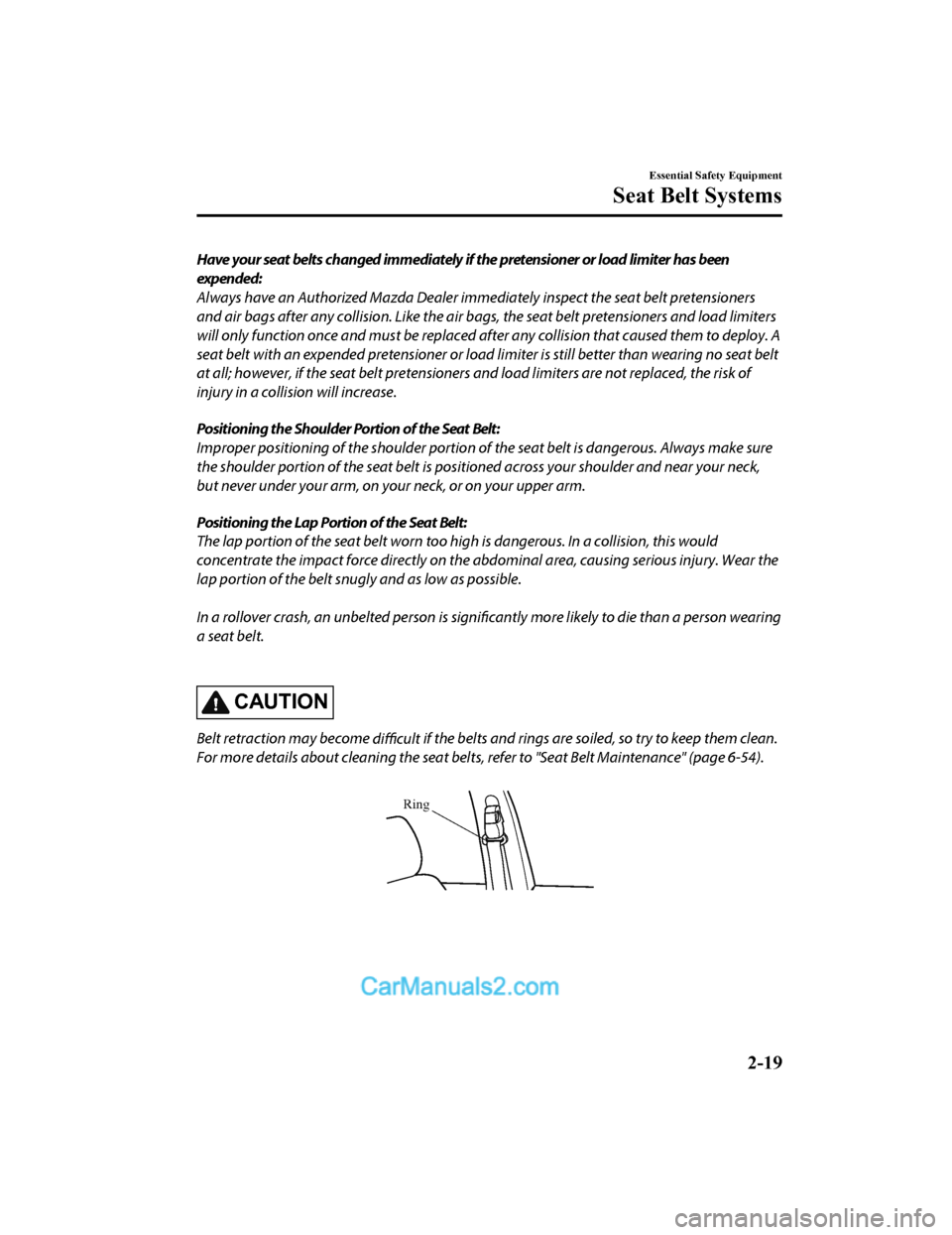
Have your seat belts changed immediately if the pretensioner or load limiter has been
expended:
Always have an Authorized Mazda Dealer immediately inspect the seat belt pretensioners
and air bags after any collision. Like the air bags , the seat belt pretensioners and load limiters
will only function once and must be replaced af ter any collision that caused them to deploy. A
seat belt with an expended pretensioner or load limiter is still better than wearing no seat belt
at all; however, if the seat belt pretensioner s and load limiters are not replaced, the risk of
injury in a collision will increase.
Positioning the Shoulder Portion of the Seat Belt:
Improper positioning of the shoulder portion of the seat belt is dangerous. Always make sure
the shoulder portion of the seat belt is positi oned across your shoulder and near your neck,
but never under your arm, on your neck, or on your upper arm.
Positioning the Lap Portion of the Seat Belt:
The lap portion of the seat belt worn too high is dangerous. In a collision, this would
concentrate the impact force directly on the abdominal area, causing serious injury. Wear the
lap portion of the belt snugly and as low as possible.
In a rollover crash, an unbelted person is significantly more likely to die than a person wearing
a seat belt.
CAUTION
Belt retraction may become difficult if the belts and rings are soiled, so try to keep them clean.
For more details about cleaning the seat belts, refer to "Seat Belt Maintenance" (page 6-54).
Ring
Essential Safety Equipment
Seat Belt Systems
2-19
CX-5_8GN5-EA-17J_Edition1 2017-8-18 12:58:27
Page 124 of 628
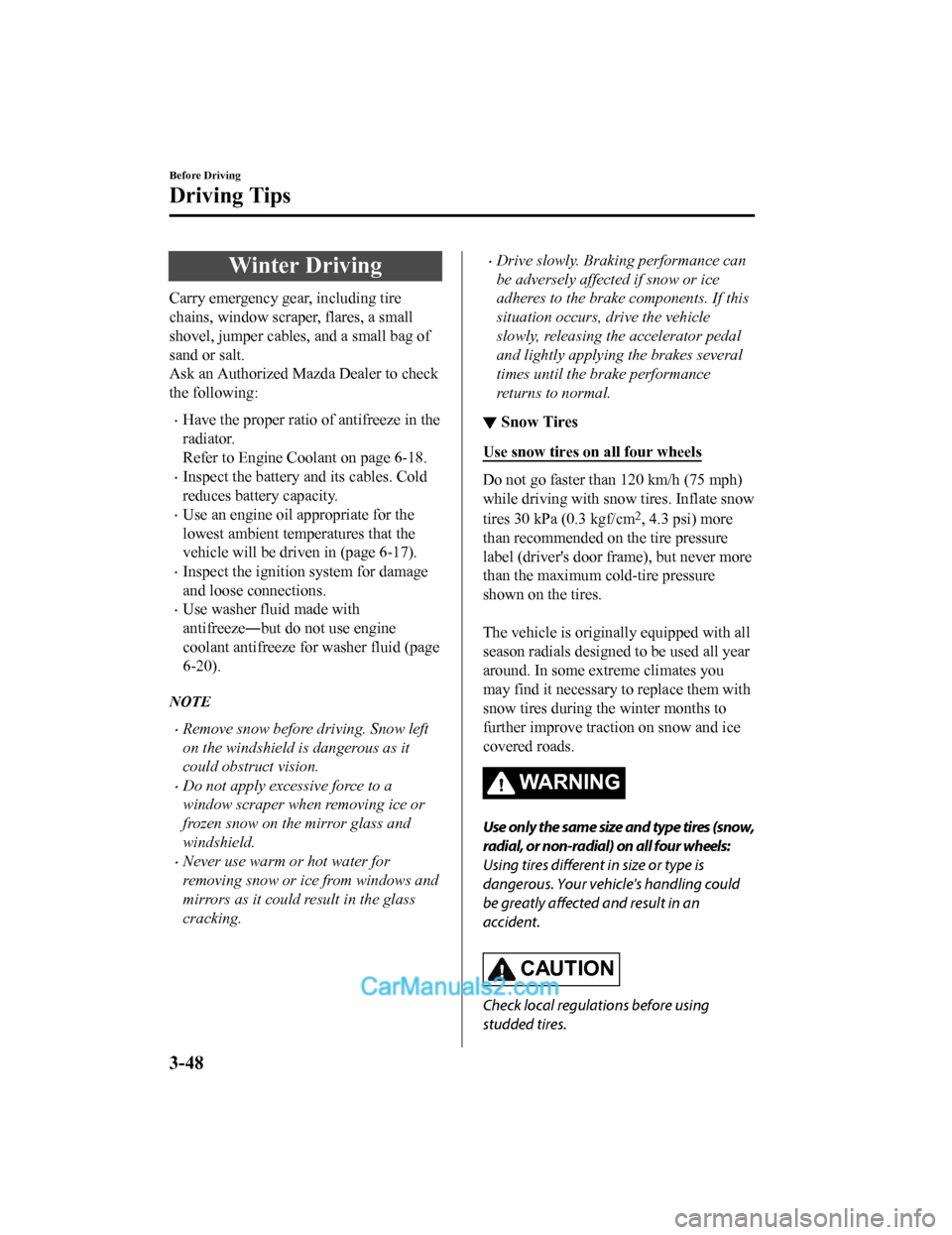
Winter Driving
Carry emergency gear, including tire
chains, window scraper, flares, a small
shovel, jumper cables, and a small bag of
sand or salt.
Ask an Authorized Mazda Dealer to check
the following:
•Have the proper ratio of antifreeze in the
radiator.
Refer to Engine Coolant on page 6-18.
•Inspect the battery and its cables. Cold
reduces battery capacity.
•Use an engine oil appropriate for the
lowest ambient temperatures that the
vehicle will be driven in (page 6-17).
•Inspect the ignition system for damage
and loose connections.
•Use washer fluid made with
antifreeze―but do not use engine
coolant antifreeze for washer fluid (page
6-20).
NOTE
•Remove snow before driving. Snow left
on the windshield is dangerous as it
could obstruct vision.
•Do not apply excessive force to a
window scraper when removing ice or
frozen snow on the mirror glass and
windshield.
•Never use warm or hot water for
removing snow or ice from windows and
mirrors as it could result in the glass
cracking.
•Drive slowly. Braking performance can
be adversely affected if snow or ice
adheres to the brake components. If this
situation occurs, drive the vehicle
slowly, releasing the accelerator pedal
and lightly applying the brakes several
times until the brake performance
returns to normal.
▼ Snow Tires
Use snow tires on all four wheels
Do not go faster than 120 km/h (75 mph)
while driving with sno
w tires. Inflate snow
tires 30 kPa (0.3 kgf/cm
2, 4.3 psi) more
than recommended on the tire pressure
label (driver's door frame), but never more
than the maximum c old-tire pressure
shown on the tires.
The vehicle is originally equipped with all
season radials designed to be used all year
around. In some extreme climates you
may find it necessary t o replace them with
snow tires during the winter months to
further improve traction on snow and ice
covered roads.
WA R N I N G
Use only the same size and type tires (snow,
radial, or non-radial) on all four wheels:
Using tires different in size or type is
dangerous. Your vehi cle's handling could
be greatly affected and result in an
accident.
CAUTION
Check local regulations before using
studded tires.
Before Driving
Driving Tips
3-48
CX-5_8GN5-EA-17J_Edition1 2017-8-18 12:58:27
Page 160 of 628
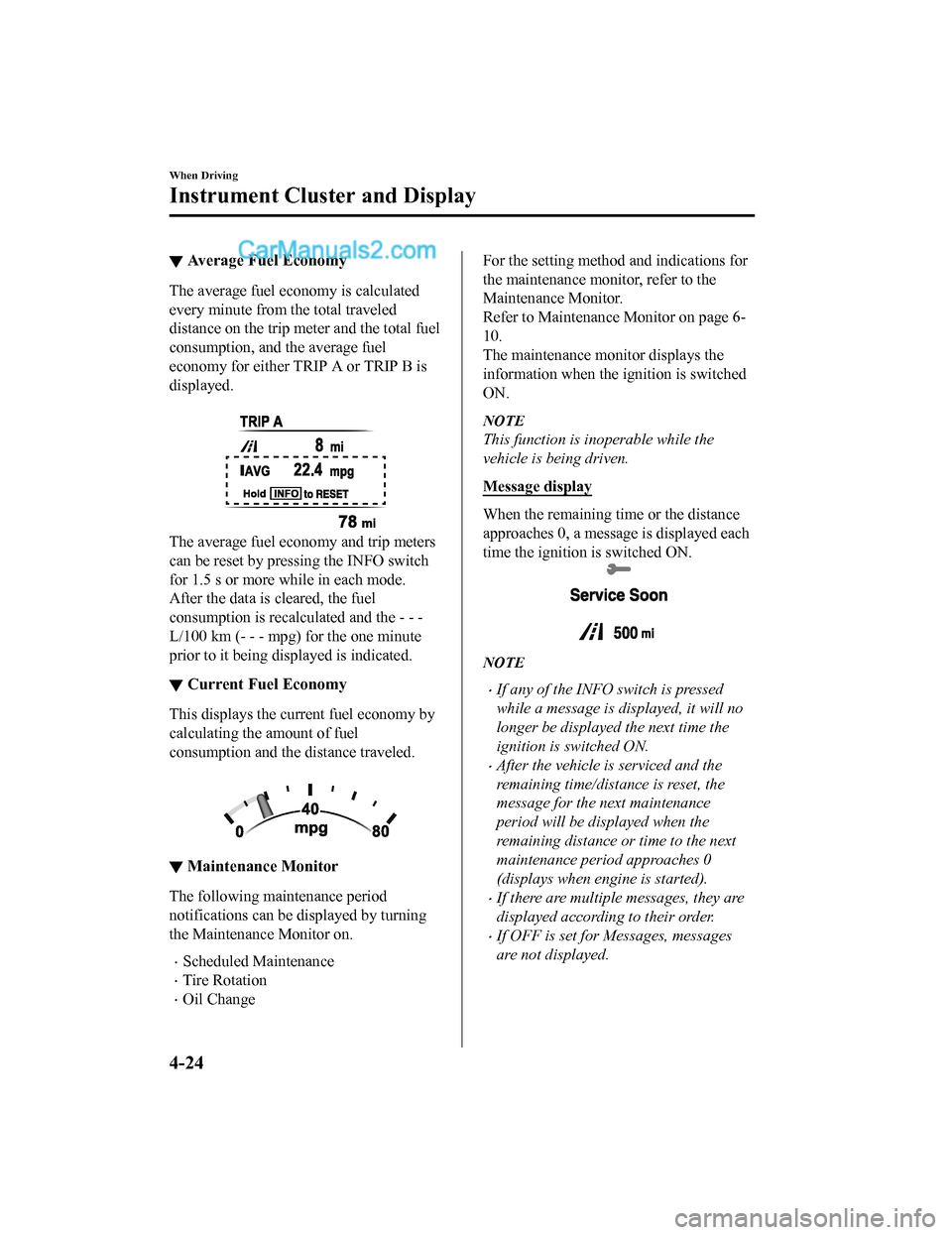
▼Average Fuel Economy
The average fuel economy is calculated
every minute from the total traveled
distance on the trip met
er and the total fuel
consumption, and the average fuel
economy for either TRIP A or TRIP B is
displayed.
The average fuel economy and trip meters
can be reset by pressing the INFO switch
for 1.5 s or more wh ile in each mode.
After the data is cleared, the fuel
consumption is recalculated and the - - -
L/100 km (- - - mpg) for the one minute
prior to it being displayed is indicated.
▼ Current Fuel Economy
This displays the current fuel economy by
calculating the amount of fuel
consumption and the distance traveled.
▼
Maintenance Monitor
The following maintenance period
notifications can be displayed by turning
the Maintenance Monitor on.
•Scheduled Maintenance
•Tire Rotation
•Oil Change
For the setting method and indications for
the maintenance monitor, refer to the
Maintenance Monitor.
Refer to Maintenance Monitor on page 6-
10.
The maintenance mo
nitor displays the
information when the i gnition is switched
ON.
NOTE
This function is inoperable while the
vehicle is being driven.
Message display
When the remaining time or the distance
approaches 0, a message is displayed each
time the ignition is switched ON.
NOTE
•If any of the INFO switch is pressed
while a message is displayed, it will no
longer be displayed the next time the
ignition is switched ON.
•After the vehicle is serviced and the
remaining time/distance is reset, the
message for the next maintenance
period will be displayed when the
remaining distance or time to the next
maintenance period approaches 0
(displays when engine is started).
•If there are multiple messages, they are
displayed according to their order.
•If OFF is set for Messages, messages
are not displayed.
When Driving
Instrument Cluster and Display
4-24
CX-5_8GN5-EA-17J_Edition1 2017-8-18 12:58:27
Page 167 of 628
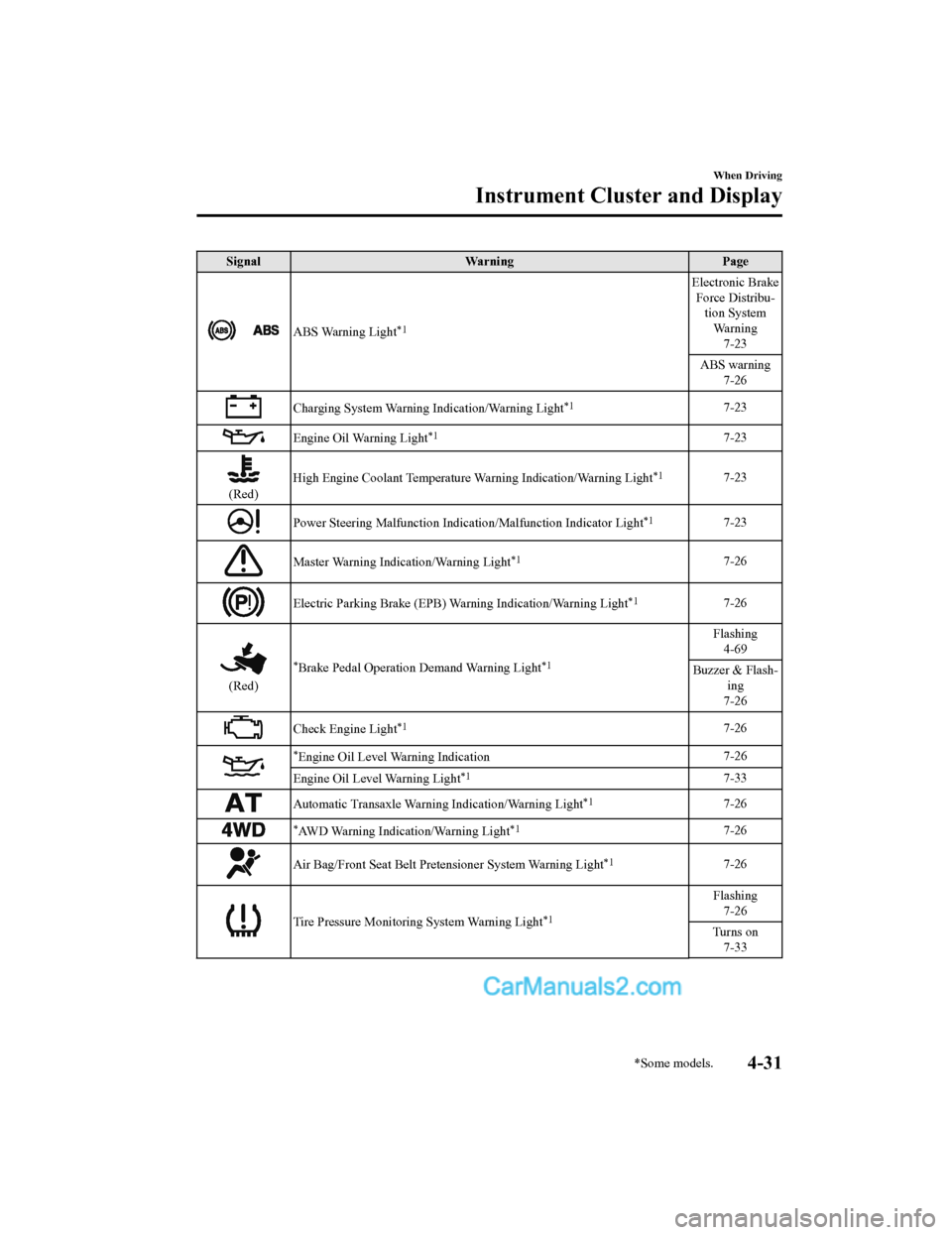
SignalWarning Page
ABS Warning Light*1
Electronic Brake
Force Distribu- tion System
Wa r n i n g 7-23
ABS warning 7-26
Charging System Warning Indication/Warning Light*17-23
Engine Oil Warning Light*17-23
(Red) High Engine Coolant Temperature
Warning Indication/Warning Light
*17-23
Power Steering Malfunction Indication/Malfunction Indicator Light*17-23
Master Warning Indication/Warning Light*17-26
Electric Parking Brake (EPB) Warning Indication/Warning Light*17-26
(Red)
*Brake Pedal Operation Demand Warning Light*1
Flashing
4-69
Buzzer & Flash- ing
7-26
Check Engine Light*17-26
*Engine Oil Level Warning Indication 7-26
Engine Oil Level Warning Light
*17-33
Automatic Transaxle Warning Indication/Warning Light*17-26
*AWD Warning Indication/Warning Light*17-26
Air Bag/Front Seat Belt Pretensioner System Warning Light*17-26
Tire Pressure Monitoring System Warning Light*1
Flashing 7-26
Turns on 7-33
When Driving
Instrument Cluster and Display
*Some models.4-31
CX-5_8GN5-EA-17J_Edition1 2017-8-18 12:58:27
Page 172 of 628
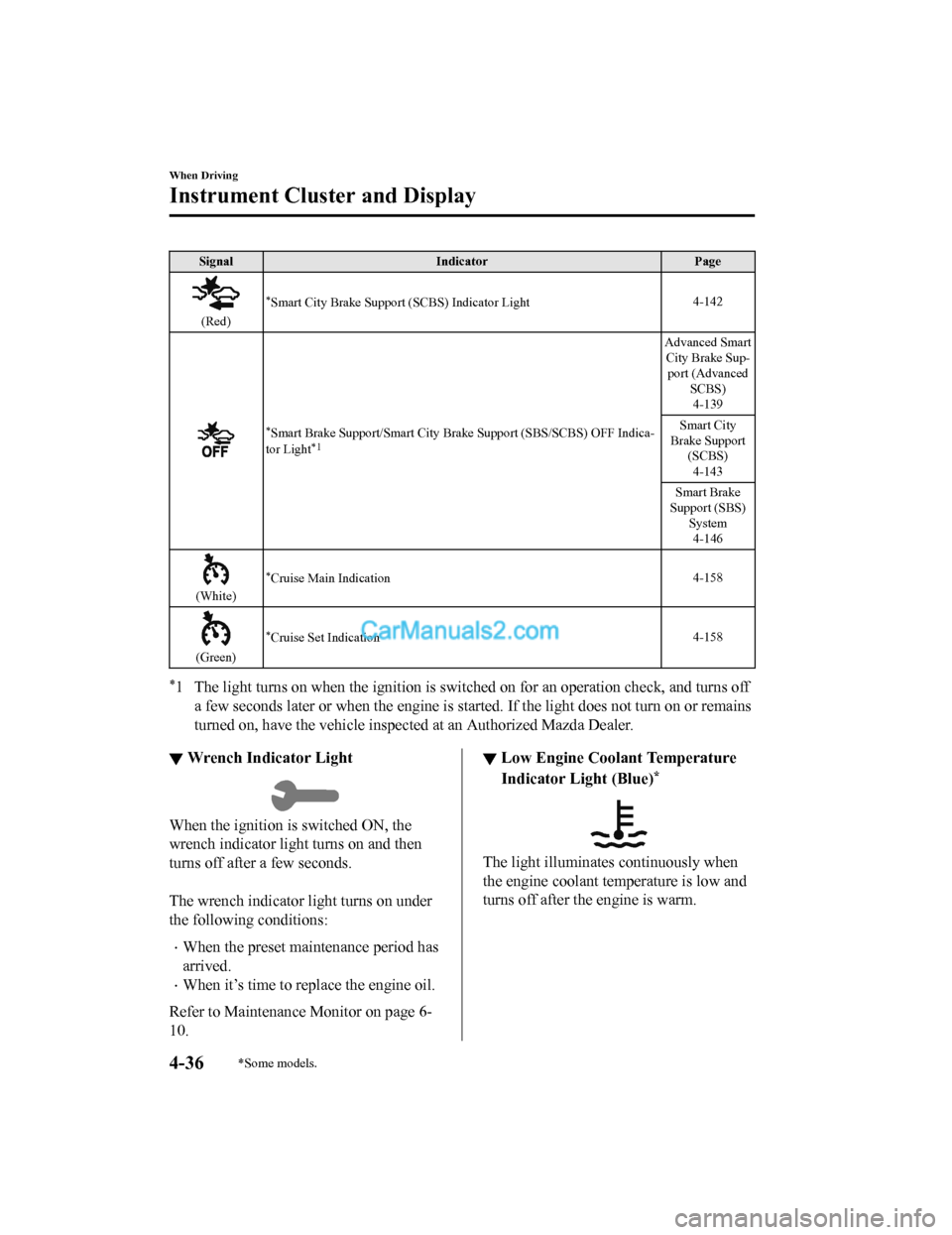
SignalIndicator Page
(Red)
*Smart City Brake Support (SCBS) Indicator Light 4-142
*Smart Brake Support/Sma
rt City Brake Support (SBS/SCBS) OFF Ind ica-
tor Light*1
Advanced Smart City Brake Sup- port (Advanced SCBS)4-139
Smart City
Brake Support (SCBS)
4-143
Smart Brake
Support (SBS) System4-146
(White)
*Cruise Main Indication 4-158
(Green)
*Cruise Set Indication4-158
*1 The light turns on when the ignition is switched on for an ope
ration check, and turns off
a few seconds later or when the e ngine is started. If the light does not turn on or remains
turned on, have the ve hicle inspected at an Authorized Mazda De aler.
▼Wrench Indicator Light
When the ignition is switched ON, the
wrench indicator light turns on and then
turns off after a few seconds.
The wrench indicator light turns on under
the following conditions:
•When the preset maintenance period has
arrived.
•When it’s time to rep
lace the engine oil.
Refer to Maintenance Monitor on page 6-
10.
▼ Low Engine Coolant Temperature
Indicator Light (Blue)*
The light illuminates continuously when
the engine coolant temperature is low and
turns off after the engine is warm.
When Driving
Instrument Cluster and Display
4-36*Some models.
CX-5_8GN5-EA-17J_Edition1
2017-8-18 12:58:27
Page 219 of 628

i-ACTIV AWD Operation*
AWD provides excellent drivability on
snow-covered and ice-packed roads, sand
and mud, as well as on steep slopes and
other slippery surfaces.
A system malfunction or operation
conditions are indicated by a warning.
Refer to Warning Indication/Warning
Lights on page 4-30.
WA R N I N G
Never spin a wheel that is off the ground:
Spinning a wheel that is off the ground as a
result of the vehicle being stuck or in a
ditch is dangerous. The drive assembly
could be seriously damaged which could
lead to an accident or could even lead to
overheating, oil leakage, and a fire.
▼ AWD Driving
WA R N I N G
Avoid sharp turns, excessive speed and
abrupt maneuvers when driving this
vehicle:
Sharp turns, excessive speed and abrupt
maneuvering of this vehicle is dangerous
as it could result in the increased risk of loss
of vehicle control, vehicle roll-over,
personal injury or death.
This vehicle has a higher center of gravity.
Vehicles with a higher center of gravity
such as utility and AWD vehicles handle
differently than vehicles with a lower center
of gravity.
Utility and AWD vehicles are not designed
for cornering at high speeds any more than
low profile sports cars are designed to
perform satisfactorily under off-road
conditions. In addition, utility vehicles have
a significantly higher rollover rate than
other types of vehicles.
Drive carefully when the vehicle is loaded
by lowering vehicle speed and applying the
brakes earlier:
Abrupt maneuvering and sudden braking
when driving a loaded vehicle is dangerous
as the driving behavior of a vehicle with a
high center of gravity is different when it is
loaded compared to when it is not, and
could result in the loss of vehicle control
and an accident.
▼Tires and Tire Chains
The condition of the ti
res plays a large role
in the performance of the vehicle.
Moreover, to prevent adverse effects to the
drive assembly, please note the following:
Tires
•When replacing tires, always replace all
front and rear tires at the same time.
•All tires must be of the same size,
manufacture, brand and tread pattern.
Pay particular attention when equipping
snow or other types of winter tires.
•Do not mix tread-worn tires with normal
tires.
•Inspect tire inflation pressures at the
specified periods adjust to the specified
pressures.
When Driving
i-ACTIV AWD
*Some models.4-83
CX-5_8GN5-EA-17J_Edition1 2017-8-18 12:58:27
Page 285 of 628
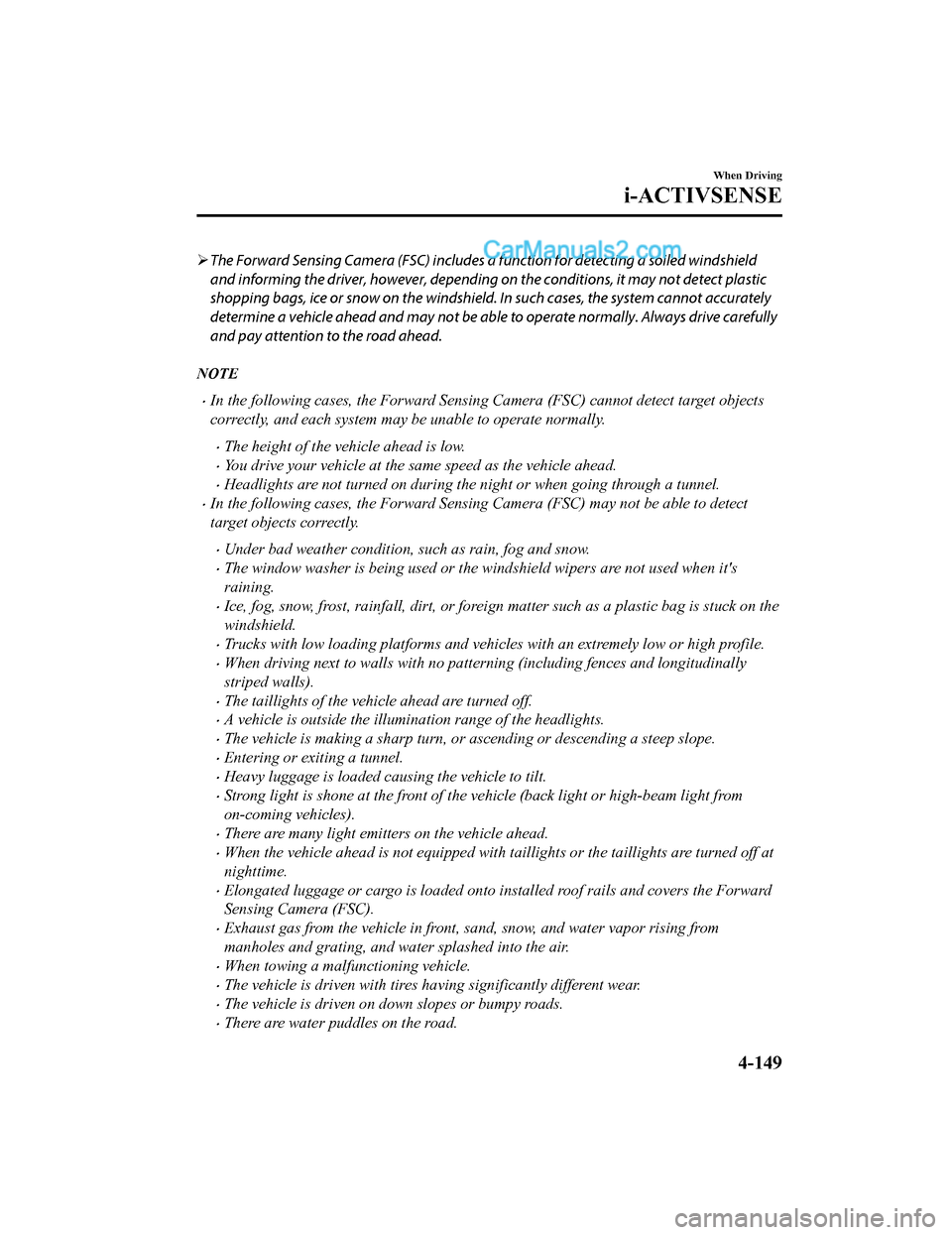
The Forward Sensing Camera (FSC) includes a function for detecting a soiled windshield
and informing the driver, however, depending on the conditions, it may not detect plastic
shopping bags, ice or snow on the windshield . In such cases, the system cannot accurately
determine a vehicle ahead and may not be able to operate normally. Always drive carefully
and pay attention to the road ahead.
NOTE
•In the following cases, the Forward Sensing Camera (FSC) cannot detect target objects
correctly, and each system may be unable to operate normally.
•The height of the vehicle ahead is low.
•You drive your vehicle at the same speed as the vehicle ahead.
•Headlights are not turned on during the night or when going through a tunnel.
•In the following cases, the Forward Sensing Camera (FSC) may not be able to detect
target objects correctly.
•Under bad weather condition, such as rain, fog and snow.
•The window washer is being used or the windshield wipers are not used when it's
raining.
•Ice, fog, snow, frost, rainfall, dirt, or foreign matter such as a plastic bag is stuck on the
windshield.
•Trucks with low loading platforms and vehicl es with an extremely low or high profile.
•When driving next to walls with no patterning (including fences and longitudinally
striped walls).
•The taillights of the vehicle ahead are turned off.
•A vehicle is outside the illumi nation range of the headlights.
•The vehicle is making a sharp turn, or ascending or descending a steep slope.
•Entering or exiting a tunnel.
•Heavy luggage is loaded causing the vehicle to tilt.
•Strong light is shone at the front of the vehicle (back light or high-beam light from
on-coming vehicles).
•There are many light emitters on the vehicle ahead.
•When the vehicle ahead is not equipped with taillights or the taillights are turned off at
nighttime.
•Elongated luggage or cargo is loaded onto installed roof rails and covers the Forward
Sensing Camera (FSC).
•Exhaust gas from the vehicle in front, sand, snow, and water vapor rising from
manholes and grating, and water splashed into the air.
•When towing a malfunctioning vehicle.
•The vehicle is driven with tires having significantly different wear.
•The vehicle is driven on down slopes or bumpy roads.
•There are water puddles on the road.
When Driving
i-ACTIVSENSE
4-149
CX-5_8GN5-EA-17J_Edition1 2017-8-18 12:58:27
Page 288 of 628

Radar Sensor (Front)*
Your vehicle is equipped with a radar sensor (front).
The following systems also use the radar sensor (front).
•Distance Recognition Support System (DRSS)
•Mazda Radar Cruise Control with S top & Go function (MRCC with Stop & Go function)
•Smart Brake Support (SBS)
The radar sensor (front) function s by detecting the radio waves reflected off a vehicle ahead
or an obstruction sent from the radar sensor.
The radar sensor (front) is m ounted behind the front emblem.
Radar sensor (front)
If “Front Radar Sensor Blocked” is displayed in the multi-infor mation display of the
instrument cluster, clean the area around the radar sensor (fro nt).
CAUTION
Heed the following precautions to assure correct operation of each system.
Do not adhere stickers (including transparent stickers) to the surface of the radiator grille
and front emblem in and around the radar sensor (front), and do not replace the radiator
grille and front emblem with any product that is not a genuine product designed for use
with the radar sensor (front).
The radar sensor (front) includes a function for detecting soiling of the radar sensor's front
surface and informing the driver, however, depending on the conditions, it may require
time to detect or it may not detect plastic shopping bags, ice or snow. If this occurs, the
system may not operate correctly, therefore al ways keep the radar sensor (front) clean.
Do not install a grille guard.
If the front part of the vehicle has been dama ged in a vehicle accident, the position of the
radar sensor (front) may have moved. Stop the system immediately and always have the
vehicle inspected at an Authorized Mazda Dealer.
When Driving
i-ACTIVSENSE
4-152*Some models.
CX-5_8GN5-EA-17J_Edition1 2017-8-18 12:58:27